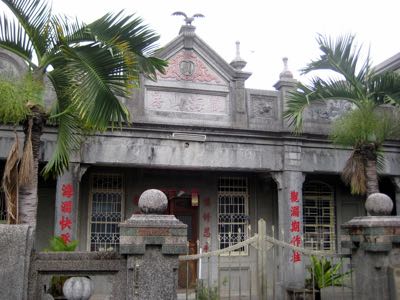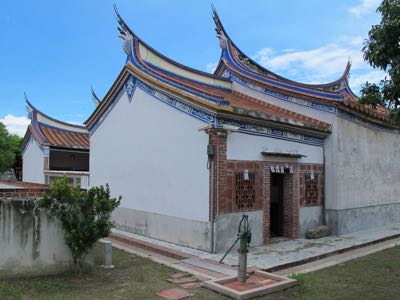These days, Taiwan is one of the safest places in the world for tourists and expatriates. But it wasn’t always so peaceful. Uprising were frequent, while settlers battled indigenous people for control of the best land. In the late 18th and early 19th centuries, Taiwan was rocked by a series of rebellions, and because there was no police force as such, many communities established militias to keep their enemies at bay.
 Fighters from Hakka towns in the south gained a reputation for bravery when helping imperial troops defeat rebels opposed to the Qing Dynasty (which ruled Taiwan between 1684 and 1895). These loyalists formed six units (liudui in Chinese), and because of them ‘Liudui’ is now a collective name for the Hakka settlements in Kaohsiung and Pingtung.
Fighters from Hakka towns in the south gained a reputation for bravery when helping imperial troops defeat rebels opposed to the Qing Dynasty (which ruled Taiwan between 1684 and 1895). These loyalists formed six units (liudui in Chinese), and because of them ‘Liudui’ is now a collective name for the Hakka settlements in Kaohsiung and Pingtung.
The Liudui Hakka Cultural Park in Pingtung County’s Neipu is designed to make Hakka traditions accessible to non-Hakka. In addition to presenting rural Hakka lifestyles and associated ecosystems, it offers tourists multimedia and DIY experiences as well as artistic performances and children’s activities.
In 1735, when two brothers surnamed Lim founded the settlement now known as Meinong, a bamboo palisade protected the settlers from bandits. These days, outsiders are warmly welcomed.
More than 90 percent of Meinong’s 40,000 people are Hakka, and among them are perhaps a hundred who earn a living by making and selling handpainted oil-paper parasols. Long before they became choice souvenirs, these gorgeous umbrellas were popular gifts when couples married. Auspiciously, the Hakka word for paper sounds like the word for children. Also, the word used to describe a parasol’s roundness has the same pronunciation as the word for completeness, so they came to symbolize family unity.
In the town’s souvenir shops, miniature parasols decorated with images of birds and flowers can be bought off the shelf. Painted-to-order versions are also available; you can pick it up a week or so later, or have it shipped direct to your home.
 Meinong Hakka Museum is a good introduction to the town’s history and culture. If, when approaching the museum, you feel its shape is unusual yet familiar, this is no doubt because Meinong has hundreds of similar structures. These sheds were constructed so tobacco – the cash crop which powered Meinong’s economy between the 1930s and the 1990s – could be cured soon after harvesting.
Meinong Hakka Museum is a good introduction to the town’s history and culture. If, when approaching the museum, you feel its shape is unusual yet familiar, this is no doubt because Meinong has hundreds of similar structures. These sheds were constructed so tobacco – the cash crop which powered Meinong’s economy between the 1930s and the 1990s – could be cured soon after harvesting.
Inside the museum, you can also learn about another Hakka symbol, the blue tunic worn by ladies until well after World War II. At least two tailoring businesses in Meinong still produce such garments, but these days most customers are tourists.
Two Hakka locations in Pingtung delight all who adore picturesque traditional architecture. In the hamlet of Wugoushui, old-style and very photogenic single-story abodes made of bricks still outnumber modern concrete-box houses. The place name, which means ‘five ditches’, reflects the importance of irrigation to the farmers who pioneered the area.
Jiadong is at the southern end of the Liudui region, and just 3 km from the sea. The principal landmark is the sprawling Hsiao Family Residence. Still owned by a Hakka clan which grew wealthy making wine and dyeing cloth, the oldest parts date from the 1860s. In the same little town, the Yang Clan Shrine is an edifice of graceful beauty. Established in 1919, it is notable for the elephants and dragons which decorate the roof. The former symbolize hopes that clansmen can attain a general’s rank or high office, while the latter are believed to protect the building against fire.
 Before touring Meinong, Wugoushui or Jiadong, make sure you’ve plenty of space on your camera’s memory card – the combination of beguiling sights and reliably excellent weather will have you snapping like there’s no tomorrow!
Before touring Meinong, Wugoushui or Jiadong, make sure you’ve plenty of space on your camera’s memory card – the combination of beguiling sights and reliably excellent weather will have you snapping like there’s no tomorrow!
Tailored Taiwan Private Tours
At Life of Taiwan, we specialise in catering to the needs of English-speaking and European visitors. Join our luxury tours, private food tours or family tours of Taiwan for an unforgettable journey through Taiwan. Contact us today to plan your perfect Taiwan private tour.
Did you miss Part 1 of our introduction to South Taiwan’s Hakka townships?
